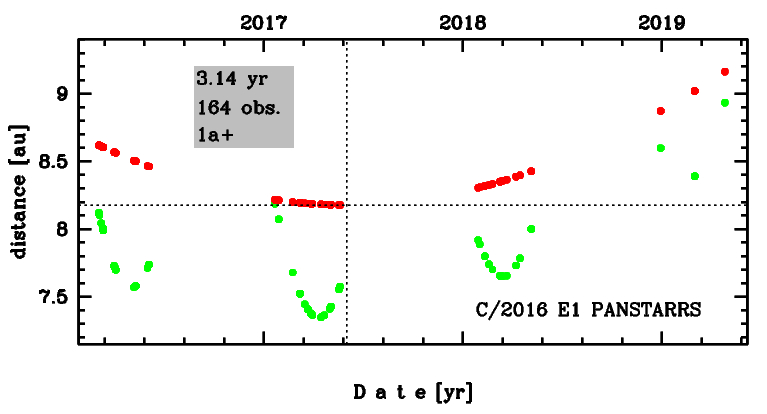C/2016 E1 PANSTARRS
more info
Comet C/2016 E1 was discovered on 3 March 2016 with Pan-STARRS 1 telescope (Haleakala), that is about 1.3 yr before its perihelion passage. This comet was observed until 1 January 2020.
Comet had its closest approach to the Earth on 10 April 2017 (7.345 au), almost 2 months before its perihelion passage.
The preferred solution given here is based on data spanning over 3.83 yr in a range of heliocentric distances: 8.62 au – 8.18 au (perihelion) – 9.90 au.
This Oort spike comet suffers rather small planetary perturbations during its passage through the planetary system; however, these perturbations likely lead to escape the comet from the planetary zone on a hyperbolic orbit (see future barycentric orbits).
Comet had its closest approach to the Earth on 10 April 2017 (7.345 au), almost 2 months before its perihelion passage.
The preferred solution given here is based on data spanning over 3.83 yr in a range of heliocentric distances: 8.62 au – 8.18 au (perihelion) – 9.90 au.
This Oort spike comet suffers rather small planetary perturbations during its passage through the planetary system; however, these perturbations likely lead to escape the comet from the planetary zone on a hyperbolic orbit (see future barycentric orbits).
| solution description | ||
|---|---|---|
| number of observations | 164 | |
| data interval | 2016 03 03 – 2019 04 25 | |
| data type | perihelion within the observation arc (FULL) | |
| data arc selection | entire data set (STD) | |
| range of heliocentric distances | 8.62 au – 8.18 au (perihelion) – 9.16 au | |
| detectability of NG effects in the comet's motion | NG effects not determinable | |
| type of model of motion | GR - gravitational orbit | |
| data weighting | YES | |
| number of residuals | 315 | |
| RMS [arcseconds] | 0.23 | |
| orbit quality class | 1a+ | |
| orbital elements (heliocentric ecliptic J2000) | ||
|---|---|---|
| Epoch | 2017 07 26 | |
| perihelion date | 2017 06 01.58401649 | ± 0.00189947 |
| perihelion distance [au] | 8.17678270 | ± 0.00001081 |
| eccentricity | 1.00309388 | ± 0.00000881 |
| argument of perihelion [°] | 47.319350 | ± 0.000111 |
| ascending node [°] | 233.036690 | ± 0.000013 |
| inclination [°] | 131.892092 | ± 0.000014 |
| reciprocal semi-major axis [10-6 au-1] | -378.37 | ± 1.08 |
